
15 Life on Land (152)
Protect, restore and promote sustainable use of terrestrial ecosystems, sustainably manage forests, combat desertification, and halt and reverse land degradation and halt biodiversity loss
Whiskey business: Help UT save white oaks for your liquor drinks
Written by Ben Pounds
UT forestry efforts benefit whiskey and ecological chasers
KNOXVILLE — Volunteers, distilleries and two universities came together this fall to collect white oak acorns to ensure the survival of the species for commercial and ecological purposes.
It was a key part of a conservation effort started by distilleries worried about the future of oak barrels and casks used to age whiskey and bourbon.
It’s about more than that though, as white oaks have many uses not just for people but for an estimated 2,000 other species, including bats, birds, turkeys, deer, rabbits and hundreds of butterflies and moths. But because the trees are slow to grow, they may be at risk, especially as the region grapples with the uncertain outcomes of climate change.
Help control invasive exotic plants Saturday at Oak Ridge cedar barrens
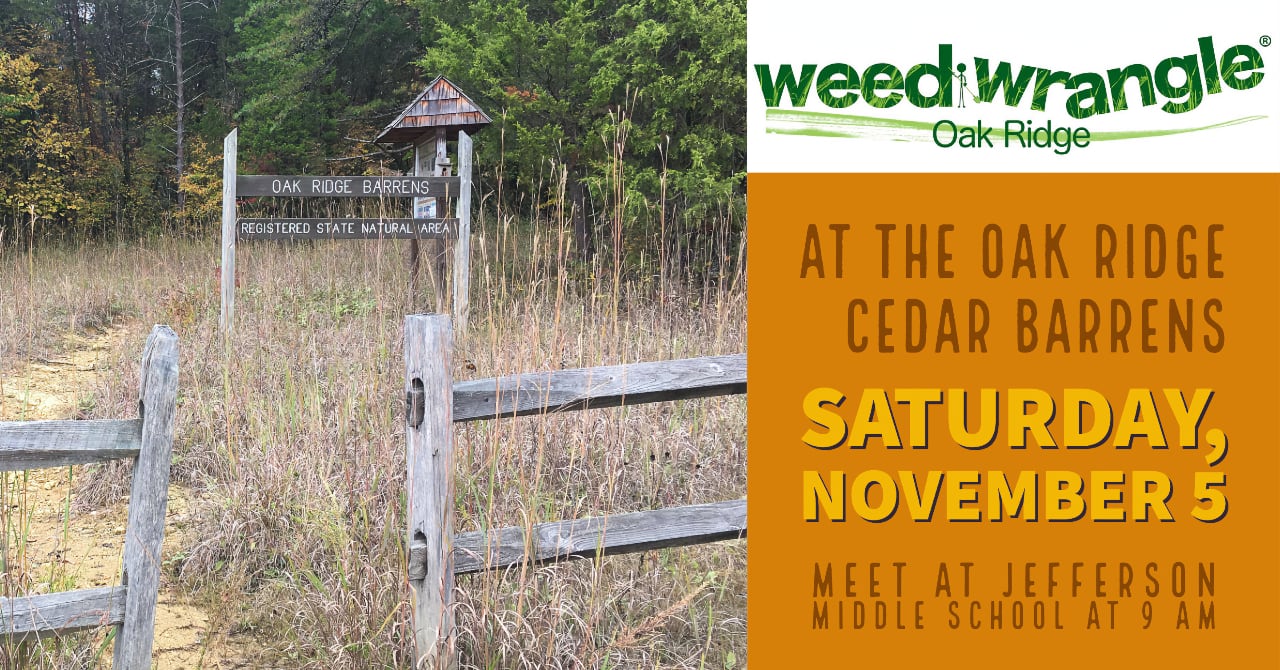
OAK RIDGE — The Oak Ridge Cedar Barren will again be the site of exotic invasive plant removal on Saturday, Nov. 5 as we conduct our fall cleanup, our third and final cleanup of the year. Located next to Jefferson Middle School in Oak Ridge, the Barren is a joint project of the City of Oak Ridge, State Natural Areas Division, and Tennessee Citizens for Wilderness Planning. The area is one of just a few cedar barrens in East Tennessee, and is subject to invasion by bushy lespedeza, leatherleaf viburnum, privet, autumn olive, mimosa, Nepal grass, multiflora rose, and woody plants that threaten the system’s prairie grasses. Our efforts help to eliminate invasives and other shade-producing plants that prevent the prairie grasses from getting needed sunlight.
Volunteers should meet in the Jefferson Middle School Parking lot at 9 a.m., with sturdy shoes, loppers, gloves, and water. The work session will conclude at noon with a pizza lunch. For more information, contact Tim Bigelow at 865-607-6781 or This email address is being protected from spambots. You need JavaScript enabled to view it..
Hellbender Press reported in detail on last year’s Cedar Barren spring cleanup.
Back to the bog: Zoo Knoxville rears and releases rare bog turtles to stop slide toward extinction
Written by Ben Pounds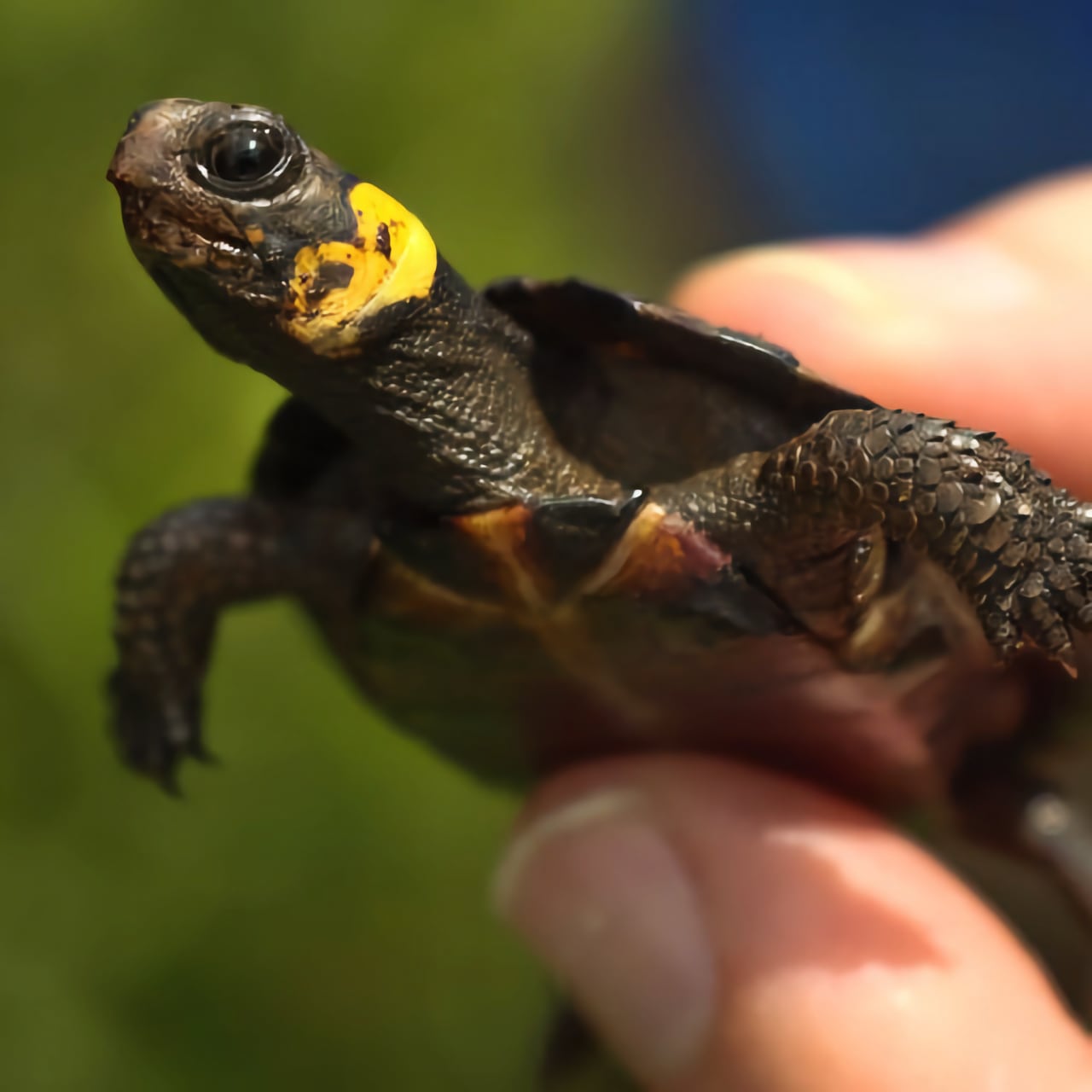 This baby bog turtle may be the face of a new generation of bog turtles raised by Zoo Knoxville for a return to the wild. Zoo Knoxville
This baby bog turtle may be the face of a new generation of bog turtles raised by Zoo Knoxville for a return to the wild. Zoo Knoxville
Bog turtles raised for resurrection at Zoo Knoxville’s ARC
KNOXVILLE — Zoo visitors might overlook the collection of critters behind a small, unremarkable window. But amid the showier gila monster, reticulated python, king cobra and Cuban crocodiles, there’s a regional species on the brink of extinction that’s worth a closer look.
Behind the glass, tiny juvenile bog turtles poke their heads out from underneath sphagnum moss at Zoo Knoxville’s Clayton Family Amphibian Reptile Conservatory (ARC).They are mostly brown, with splashes of gold on their heads. When they mature, they will move to the Bern Tryon Turtle Propagation Bog just outside. Eventually, the zoo will release the heartiest of the bunch. This process, called head-starting, involves raising the turtles from eggs and feeding them well in captivity so they’ll be bigger and have a better chance to survive after returning to the wild.
Beavers mitigate forest fires
 European Beaver Image by Ralf Schick from Pixabay
European Beaver Image by Ralf Schick from Pixabay
NPR: California enlists beavers in battle against climate change
Forest areas with beaver dams are less prone to severe fire damage because of more consistent soil moisture and less extreme air aridity and temperature conditions. Read about it or listen to Randy Simon’s 2-minute beaver podcast on National Public Radio’s Earth Wise web page.
To save butterflies, plant a billboard on an island for life
Written by Ben Pounds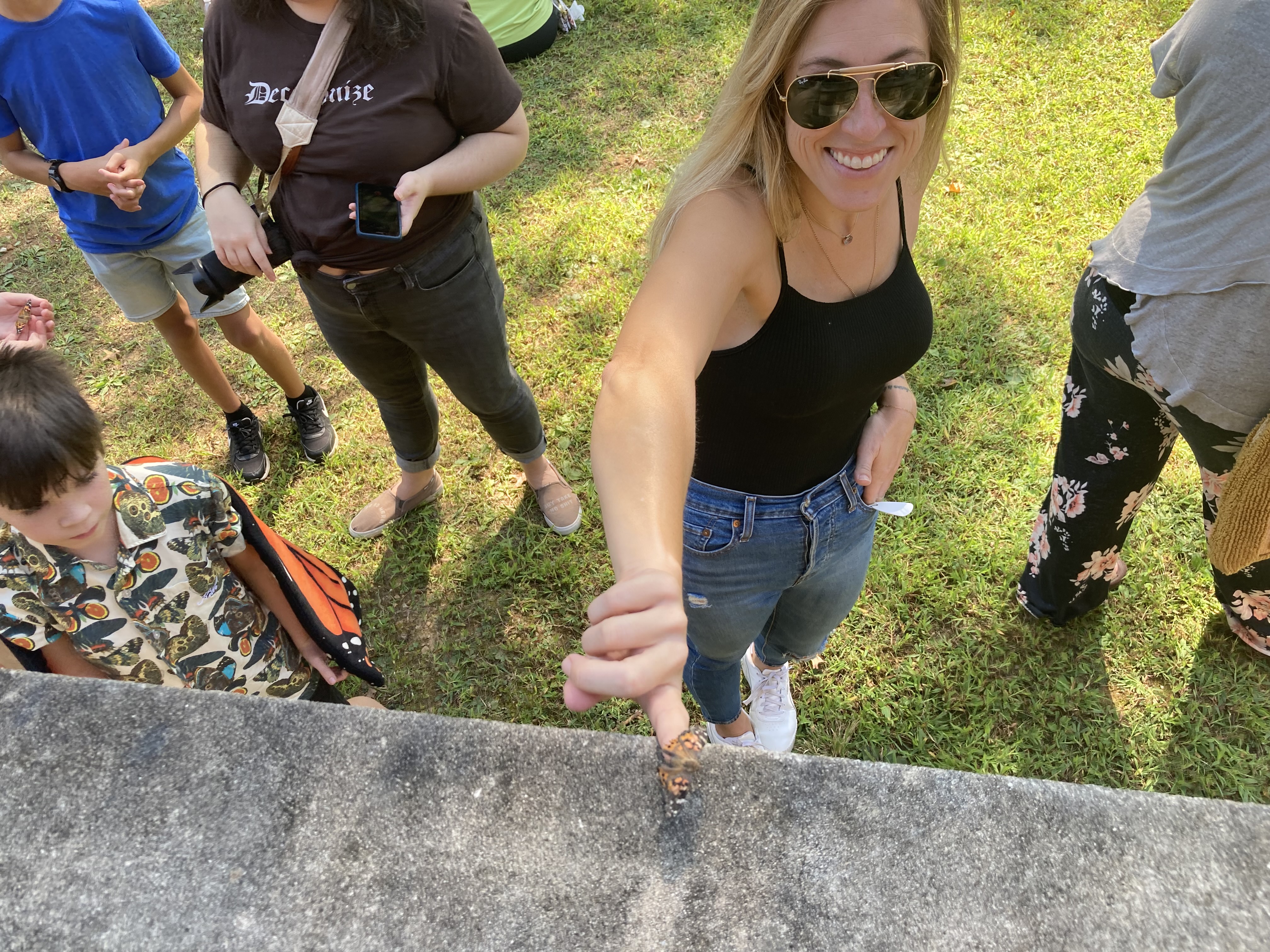 Kat Johnson meets a butterfly during a recent event at the University of Tennessee Arboretum in Oak Ridge. Ben Pounds/Hellbender Press
Kat Johnson meets a butterfly during a recent event at the University of Tennessee Arboretum in Oak Ridge. Ben Pounds/Hellbender Press
UT Arboretum event reminds us to love and care for the butterflies among us
OAK RIDGE — With an orange flutter, a cluster of painted lady butterflies took to the sky.
It was a timed release, coming toward the end of the seventh annual University of Tennessee Arboretum’s Butterfly Festival last month.
Earlier, other live painted lady butterflies were available to watch in mesh tents. Visitors got a chance to touch Madagascar hissing cockroaches and look at preserved insect collections with butterflies and other creatures from around the world. Children ran around the event with butterfly face paint, butterfly masks and butterfly wings. But the event was also a chance to buy butterfly-friendly plants and learn about butterflies and their relationships with other species.
- butterfly
- university of tennessee arboretum
- butterfly festival
- pollinator plant
- tennessee naturscapes
- michelle campanis
- stephen lynn bales
- georgeann eubanks
- family garden as butterfly habitat
- jerome grant
- migratory butterfly
- cosmopolitan butterfly
- butterfly garden
- painted lady butterfly
- zebra swallow butterfly
- tennessee state butterfly
- pawpaw
Wither wisteria: ‘People care about our land’
Written by Ben Pounds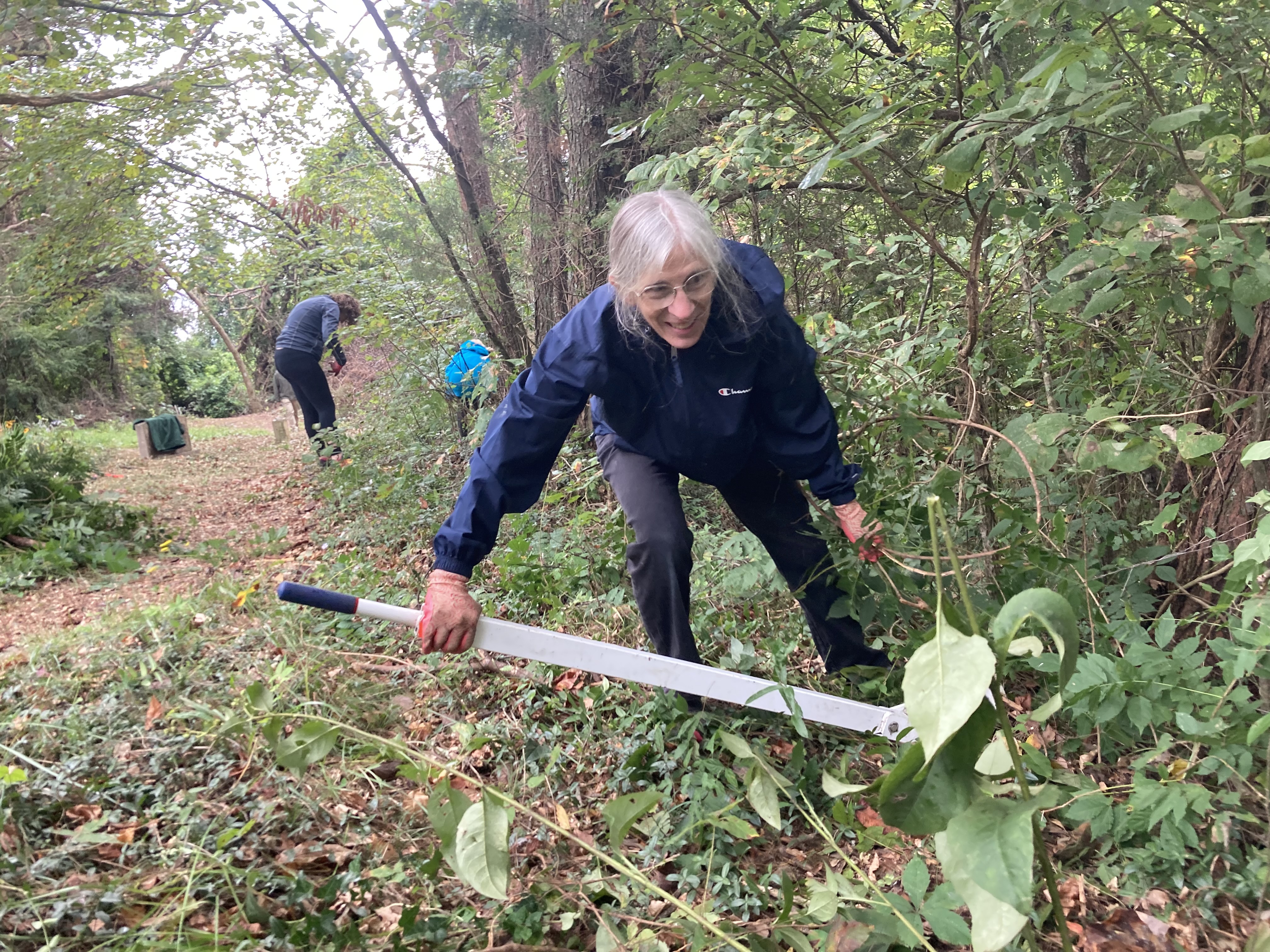 Anne Child removes invasive exotic plants during a recent Tennessee Citizens for Wilderness Planning event to mark National Public Lands Day at TVA’s Worthington Cemetery in Oak Ridge. Ben Pounds/Hellbender Press
Anne Child removes invasive exotic plants during a recent Tennessee Citizens for Wilderness Planning event to mark National Public Lands Day at TVA’s Worthington Cemetery in Oak Ridge. Ben Pounds/Hellbender Press
Citizens pay it back on Public Lands Day in Oak Ridge, Smokies and beyond
OAK RIDGE — Rain drizzled as volunteers dug and clipped plants in woods around an old cemetery turned science lab.
It was a Public Lands Day event at Tennessee Valley Authority Worthington Cemetery Ecological Study area in Oak Ridge near Melton Hill Lake. Tennessee Citizens for Wilderness Planning, an environmental organization based in Oak Ridge, led the Sept. 24 work party in support of American public lands.
Other events were held throughout the country to mark the date (including Great Smoky Mountains National Park), which has proven itself to be the most productive day of the year for citizen sweat equity in public lands.
Celebrate the wild ties that bind Americans on Public Lands Day 2022 — Saturday, Sept. 24
Written by Thomas Fraser
GATLINBURG — The director of the National Park Service is expected in Great Smoky Mountains National Park on Saturday to celebrate National Public Lands Day.
Director Chuck Sams plans to make some remarks in appreciation for the volunteers who help backstop national park maintenance costs before citizens fan out for various tasks across the park. Sams is the first Native American to head the park service, and he will be joined by Eastern Band of Cherokee Indians Chief Richard G. Sneed.
 An American alligator (Alligator mississippiensis) paints art for the fall fundraising auction for the Tennessee Aquarium. The auction runs through Sept. 26. Tennessee Aquarium
An American alligator (Alligator mississippiensis) paints art for the fall fundraising auction for the Tennessee Aquarium. The auction runs through Sept. 26. Tennessee Aquarium
Wildlife masterpieces mark an artistic autumnal fundraiser for the Tennessee Aquarium
CHATTANOOGA — While getting ready to tackle his next artistic masterpiece at the Tennessee Aquarium, Avior the red-ruffed lemur likes to take a few steps to center himself: languid naps in the sunshine, delicate nibbles of romaine lettuce, a resounding howl to focus his energy.
Only after these rituals are complete can this master of composition — a true “Lemur-nardo” da Vinci — begin putting paw and tail to canvas to create his next opus.
Avior’s latest triumph — made using non-toxic, animal-friendly tempura paint, naturally — is a 16-by-20-inch piece created in collaboration with his fellow lemurs and social media star Atlanta-based artist Andrea Nelson (TikTok video). Avior and Nelson’s masterwork is one of more than two dozen pieces of art made by aquarium animals now up for bid during the Tennessee Aquarium’s online fall fundraising auction. The auction will conclude at noon on Monday, Sept. 26.
Plant native species to help the world just outside your door
Written by Ben Pounds Gerry Moll is seen in the native garden of his home in the 4th and Gill neighborhood of Knoxville. Ben Pounds/Hellbender Press
Gerry Moll is seen in the native garden of his home in the 4th and Gill neighborhood of Knoxville. Ben Pounds/Hellbender Press
People are restoring native plants on their properties. You should, too.
‘There are a lot of messes out there and this is something that you can do right at home that has a positive effect.’
KNOXVILLE — If you want to help native wildlife and attract it to your yard, plant some native plants and kick back on your porch and watch them grow. That’s a good place to start.
That’s the message from Native Plant Rescue Squad founders Gerry Moll and Joy Grissom.
People walking by Moll’s garden in the Fourth and Gill neighborhood off Broadway just north of the city center will see tall plants; not hedges or other foreign plants, but various short trees and native flowers. It looks like an explosion of growth on both sides of the sidewalk, but it’s not chaos.
- plant native species
- plant conservation
- plant rescue
- replace your lawn
- native species knoxville
- ben pounds journalist
- native grass
- native plant rescue squad
- gerry moll
- make your yard wild
- attract wildlife to your yard
- joy grissom
- 4th and gill knoxville
- basic habitat needs of wildlife
- garden for wildlife
- national wildlife federation
Hunters are invited to go whole hog on the Tennessee side of Big South Fork
Written by Thomas Fraser Wild hogs are seen rooting in a sensitive area. Hog season opens later this month in Big South Fork. National Park Service
Wild hogs are seen rooting in a sensitive area. Hog season opens later this month in Big South Fork. National Park Service
ONEIDA — Big South Fork National River and Recreation Area this week announced regulations for those wanting to kill invasive wild hogs during the 2022 fall and winter seasons.
Most hog populations within the protected areas of BSF are believed to be present on the Tennessee side of the park, which spans the Kentucky border. Feral hogs have been present in East Tennessee for generations. They destroy local flora and fauna mainly by rooting in low-lying mountain and valley areas. They are especially fond of salamanders, many species of which are in grave decline. In Great Smoky Mountains National Park, hunters are regularly deployed to cull hogs throughout the park.
“The wild hog is an invasive exotic species that has a significant negative impact to native species and do a great deal of damage to farmlands and residential areas. The damage they cause threatens park resources including federally listed plants,” according to a release from the park service.
More...
Citizen scientists are taking stock in Smokies, and the inventory keeps increasing
Written by Thomas Fraser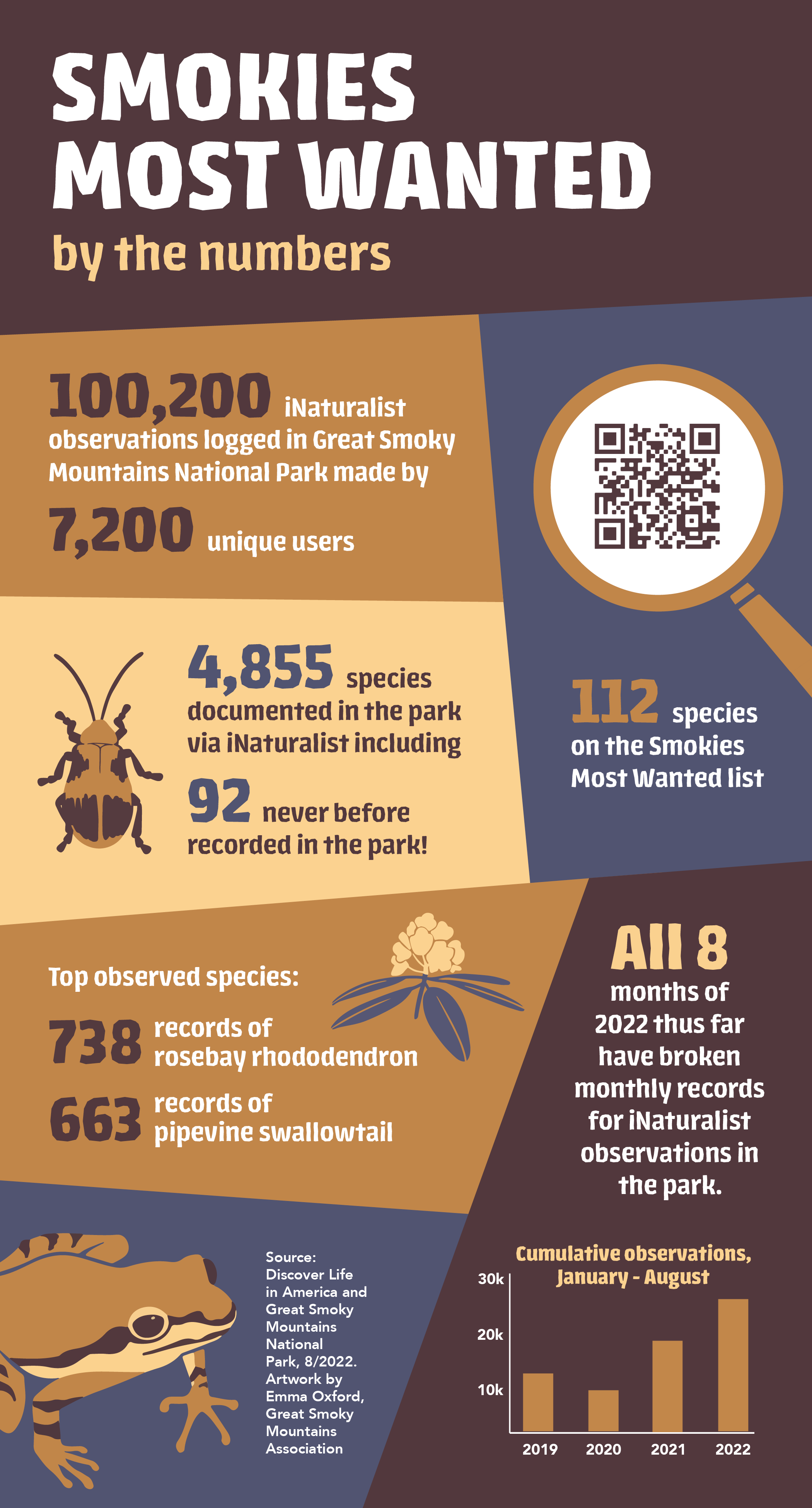
This story was provided by Great Smoky Mountains National Park.
Next demonstration on Thursday, Oct. 20
GATLINBURG — Great Smoky Mountains National Park is celebrating the success of a community science project led by nonprofit partner Discover Life in America (DLiA) called Smokies Most Wanted. The initiative encourages visitors to record life they find in the park through the iNaturalist nature app. DLiA and the park use these data points to map species range, track exotic species, and even discover new kinds of life in the park.
“iNaturalist usage in the Smokies has skyrocketed from just four users in 2011, to 3,800 in 2020, to now more than 7,100 users,” said Will Kuhn, DLIA’s director of science and research.
In August, the project reached a milestone, surpassing 100,000 records of insects, plants, fungi, and other Smokies life submitted through the app. Among them are 92 new species not previously seen in the park.
Last chance for comments in support of saving the country’s best remaining forests
 Old Growth U.S. National Park Service
Old Growth U.S. National Park Service
On July 14, the U.S. Department of Agriculture and U.S. Department of the Interior opened a public comment period following President Biden’s Executive Order to conserve mature and old-growth forests.
The deadline for comments is Tuesday, Aug. 30. Now is the time to protect our federally managed forests to safeguard our communities from the future impacts of climate change. Make your voice heard and submit a comment to the U.S. Forest Service and the Bureau of Land Management.
The mature and old-growth trees in our federally managed forests are one of this country’s greatest resources. These forests provide critical habitats for wildlife, prevent erosion and flooding, protect our drinking water, and are an essential climate solution.
United States forests cover about 290 million hectares of land and make up the fourth largest forest area of any country in the world. In 2019, the carbon sequestered in these forests offset approximately 12 percent of United States greenhouse gas emissions.
— Sierra Club
There’s a whole world in the dirt beneath your feet
Written by Tara Lohan The Dust Bowl of the 1930s resulted in the displacement of tons of soil in the midst of a drought similar to the one that grips the Southwest today. Library of Congress
The Dust Bowl of the 1930s resulted in the displacement of tons of soil in the midst of a drought similar to the one that grips the Southwest today. Library of CongressDirt is far from just dirt. It’s a foundation for life.
This story was originally published by The Revelator.
Look down. You may not see the soil beneath your feet as teeming with life, but it is.
Better scientific tools are helping us understand that dirt isn’t just dirt. Life in the soil includes microbes like bacteria and fungi; invertebrates such as earthworms and nematodes; plant roots; and even mammals like gophers and badgers who spend part of their time below ground.
It’s commonly said that a quarter of all the planet’s biodiversity lives in the soil, but that’s likely a vast understatement. Many species that reside there, particularly microorganisms such as viruses, bacteria, fungi and protists, aren’t yet known to science.
- the revelator
- soil type
- soil moisture
- why is soil important
- drought
- soil microbe
- biodiversity
- soil microorganism
- nutrient cycling
- reading university
- climate change
- soil degradation
- plastic pollution
- genetically modified organism
- pesticide
- artificial fertilizer
- land use change
- compaction
- erosion
- convention on biodiversity
- soil biodiversity observation network
- global soil biodiversity initiative
- ecosystem research
- multidimensionality
- macroecology
- farm to fork strategy
- microbial transplants
- soil quality
- soil sealing
Monarch butterflies, an ephemeral but regular glimpse of beauty, are fluttering toward extinction
Written by Stephen Lyn Bales  A monarch butterfly, recently declared endangered despite decades of conservation, is seen atop a coneflower. Stephen Lyn Bales
A monarch butterfly, recently declared endangered despite decades of conservation, is seen atop a coneflower. Stephen Lyn Bales
Dramatic monarch declines mean the bell tolls for we
KNOXVILLE — Monarch butterflies are ephemeral by nature. The orange and black dalliances that flitter through our lives, our yards, and our countryside like motes of dust are here one minute and gone the next. We pause for a few seconds to watch the “flutter-bys” and then move on.
For about all of the Lepidopteran family, where they come from, where they go, their raison d'être, we don’t ask. They are winged wisps that pass through our busy lives. But that is not true with this orange and black butterfly, named to honor King William III of England, the Prince of Orange. But two people did ask.
Norah and Fred Urquhart lived in Southern Canada and in the late 1930s they noticed that the monarch butterflies seemed to all be fluttering south this time of the year. Could they possibly be migrating and if so, where did they go? The notion that a butterfly might migrate south for the winter seemed hard to fathom. Yes, broad-winged hawks migrate. But a flimsy butterfly?
- monarch butterfly
- monarch
- are monarchs endangered?
- stephen lyn bales
- stephen bales
- ijams nature center
- lepidoptera
- catalina aguado
- norah and fred urquhart
- flight of the butterflies
- xerces society
- great smoky mountains institute at tremont
- danaus plexippus ssp plexippus
- endangered species
- international union for conservation of nature
- pesticide
- pollinator
- habitat loss
- climate change
- herbicide
- mexico